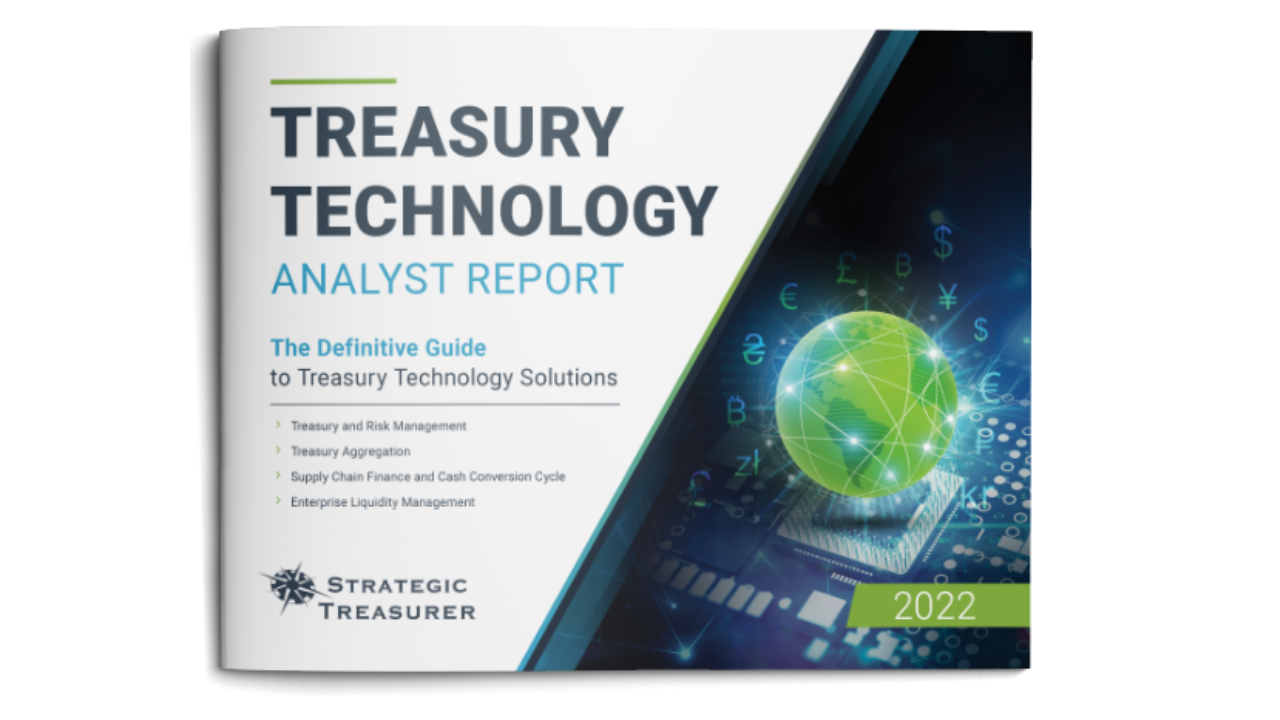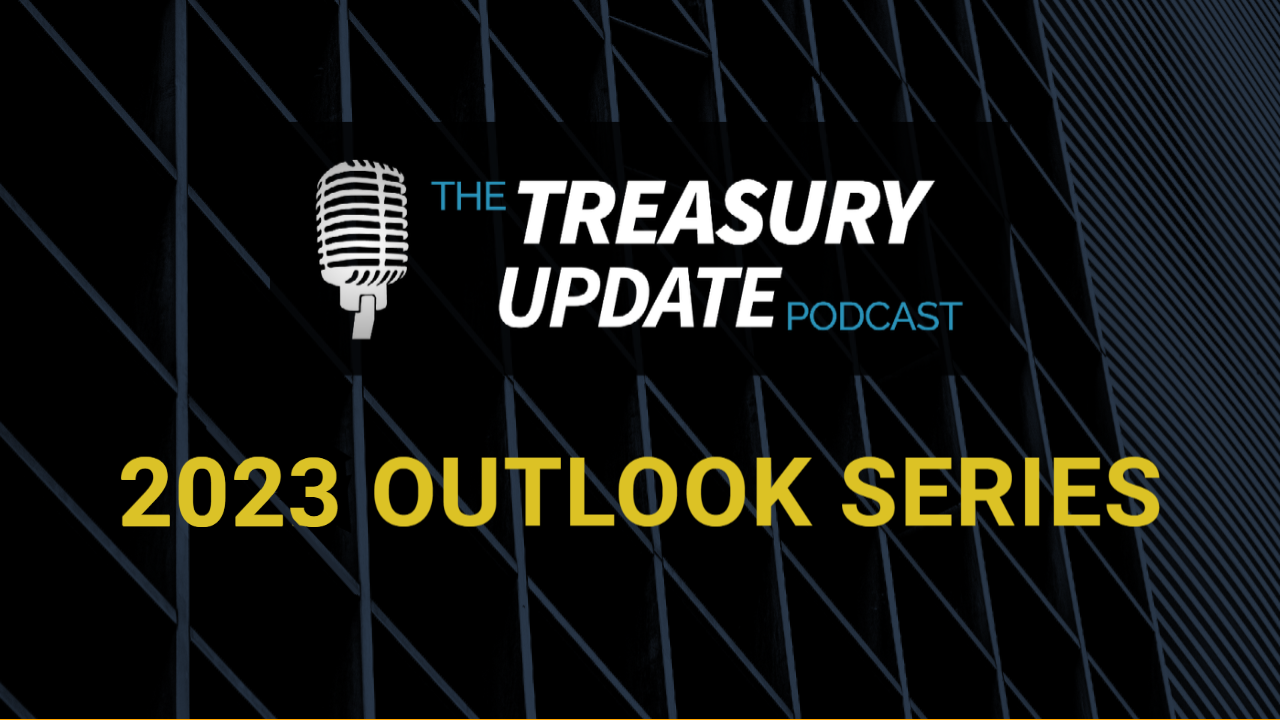
Episode 237
2023 Outlook Series:
The Labor Market Is Broken!
In this first episode of our 2023 Outlook Series, Craig Jeffery of Strategic Treasurer talks with Tony Carfang of the Carfang Group. They discuss Tony’s outlook on the coming year, covering topics such as inflation, debt, government spending, and corporate cash.
Read the History of the Federal Reserve.
Host:
Craig Jeffery, Strategic Treasurer


Speaker:
Tony Carfang, The Carfang Group


Episode Transcription - Episode #237 - 2023 Outlook Series: The Labor Market Is Broken!
Announcer 00:04
Welcome to the Treasury Update Podcast presented by Strategic Treasurer, your source for interesting treasury news, analysis, and insights in your car, at the gym, or wherever you decide to tune in.
Craig Jeffery 00:20
Welcome to the Treasury Update Podcast. This is Craig Jeffery, your host today. This is the 2023 Outlook Series. And today I’m joined with Tony Carfang, from the Carfang group. Tony, welcome, again to the Treasury Update Podcast.
Tony Carfang 00:35
Thank you, Craig, happy to be here happy to be in front of your audience.
Craig Jeffery 00:39
You know, before we get into your outlook, particularly on the, you know, inflation and, and funds and cash, what are some of the things you’ve been working on lately? Or the things items that you’ve been following? You know, any books that you’ve been reading, even that, that you can share with the audience?
Tony Carfang 00:56
Well, I read the history of the Federal Reserve a couple of months ago. Great volume talking about all the reasons why we needed a central bank in the first place. I’m still not convinced. But it was a fascinating read. Interesting politics back then. And a bunch of compromises that gave us the system that we have today. So it’s a fascinating read. Actually, I’ve been following the Fed very closely. I’ve been active in the financial regulatory front. And looking at the how the clients discern what’s happening with the inflation and interest rates, and the Feds macro economic policy. The Fed has a hugely inflated balance sheet, central banks around the world have a hugely inflated balance sheet, grown 11 fold since the global financial crisis started 12 years ago, 14 years ago, time flies. But that that’s that’s a hell of a range of growth, a lot of liquidity in the system that is creating an unstable situation. And so we’re watching that very closely for our clients.
Craig Jeffery 01:59
Yeah, thanks. Thanks for that, Tony. We’ll put we’ll put the book in the show notes too, just so people can can follow along. You know, as we as we look out, over 2023, maybe a quick recap of 2022, we saw inflation continue what was supposed to be very temporary, and it became much more permanent, the Federal Reserve has moved kind of in a hyper state to hyperscale to raise it up a number of 75 basis point increases, ending the year with a 50 basis point increase, trying to tamp down inflation, as you think about 2023, who are you paying attention to? What are you paying attention to the most for 2023?
Tony Carfang 02:39
Well, I’m paying very close attention to the Fed and other central banks around the world, particularly the major ones, the Bank of England, European Central Bank, Bank of Japan, all of whom did some tightening over the course of 2022. That tightening by the way, we don’t believe is nearly sufficient to solve the problem. If you look back over the history of inflation of prior inflation’s there’s never been any such thing as a transitory inflation. Never. You know, people cite Paul Volcker, the inflation Slayer back in 1980, or 1981. I actually posted a trivia question on my blog several months ago. But how long did that last inflation cycle last? I gave four choices like 20 months, 30 months, 40 months, or 197 months? The answer is D. You if you listen to the regulators, or if you listen to the monetary policy powers to be there’s no conception that this is going to last for 15 years. But the last one did, and it kept coming back that lot in the last cycle there were actually four intermediate peaks, and then declines until inflation ultimately peaked in 1981. You know, we hit a peak and we’re now done for six consecutive months annualized inflation. This follows six months in a row. Craig, in the last cycle, that happened six times before inflation hit its ultimate peak. Inflation peak had six consecutive months of decline, mucked around a little bit, went back up another six consecutive months. So here we are, with our first six month decline, and the administration is claiming victory. The markets are claiming victory, the Dow is at 34,000, Bitcoin is going up. And I’m like, Guys, let’s take a step back here and look at what’s really going on. So if you think about it from a macro economic level, inflation is simply lack of supply an increase of demand. If you look at what has caused the lack of supply, there are two, two primary factors that contribute to that. One is supply chain problems. The other is labor shortages that are causing supply to be constrictive, which puts upward pressure on prices from the supply side. Well, supply chain problems are being resolved. That’s the transitory part. But the labor problems, if anything, are becoming even more serious as the labor shortage declines, the unemployment rate is at rock bottom yet people can’t people can’t find workers, job wanted is still above all time high, the labor market is broken, that needs to be fixed before the supply side of the inflationary pressures abate. Now, if you look at the demand side, we have all of the short term demand as a result of the COVID-related stimulus. And we seem to still be stimulating, although COVID seems to have kind of reached a some sort of equilibrium, whatever the healthcare people call it. That’s about to decline, the the the the COVID-related stimulus. So that part of the demand equation is is likely to abate so therefore transitory. But the other part of the demand equation is government spending. What’s government spending? Governments around the world with deficit spending, the US government, one and a half trillion dollars, that’s about 5% of GDP, of excess demand. That’s a lot of excess, and not just the deficit. That’s not the spending. So the government is creating excess demand. And there seems to be, you know, we just saw that last month with the budget bill that’s in place through October, that excess demand is still in place. That’s not transitory. So we still have a substantial supply side problem in the labor market. And the demand side problem with federal government deficits. By the way, the Federal Reserve can’t control either of those. And that’s that’s the issue, Craig. That that, and that’s the issue confronting treasures.
Craig Jeffery 07:03
Yeah, some of those demand and supply. You know, some of those are the the labor force some of the changes the the retirement of the baby boomers, changing population elements as well. I mean, there’s big shifts that are, those aren’t, those aren’t changed for the policy, not quickly, you know, Tony, your group, the Carfang group puts out the US cash letter cash report, I can never remember what the exact title is, we’ll put a link in the show notes. You know, corporate cash has been at pretty high levels. Since we started COVID, people stocked up on cash. Can you summarize what’s been happening with corporate cash, and what you expect to occur in 2023? I know some of the things you’ve said are a little foreshadowing of that. But if you could give us a rundown there.
Tony Carfang 07:50
As recently as during the global financial crisis in 2008, corporate cash stood at about one and a half trillion dollars, and it was growing steadily, at a fairly constant rate relative to GDP. But in in 2020, with COVID, and all of the stimulus, corporate cash spike to $4 trillion. That’s up from from one and a half trillion in 2008. So you know, it was about a trillion and a half dollars above its long term trend line, it has since retraced about half of that. So corporate cash is now down at about three and a half trillion, but still several hundreds of billions close to a trillion dollars. above its long term trend line. Corporate treasurers are facing quite a bit of uncertainty. It’s one thing when you’re borrowing at zero interest to pad your balance sheet with excess cash as a precaution, but at 5, 6, 7 percent, and for non-rated companies, capital costs are higher than that. There’s a huge carrying costs for this excess cash. That’s a big drag on the economy. We expect some of that excess corporate cash, which is the result of increase in short term borrowing to decline as companies choose to deploy that cash by paying down debt. Obviously, there’ll be some deployment of corporate cash into capital expenditures, plant and equipment and technology projects. But I think paying down variable rate debt is going to be the you know, the primary use. And in 2023, I think you know, treasures are are simply going to take a wait and see attitude. They’re going to be minding their capital structure. How much debt should they have on a balance sheet, how much equity, how much liquidity should they be holding? Because they know that they need to navigate the headwinds, they’re going to be dictated by inflation, inflation reduction efforts, monetary policy, trade issues, trade imbalances, foreign currency and the dollar which was soaring in 2020 is, excuse me, 2022 has fallen 10% from this high. Is it going to bounce back? I think a will, as the Fed decides it needs to continue to tighten, as inflation stops declining as fast as it has been. But we don’t know in the treasurer’s job is isn’t to gamble, the treasurer’s job is to be defensive. You have to be the custodian of the company’s assets, and therefore maintain sufficient excess cash, you know, subject to reasonable carrying cost.
Craig Jeffery 10:33
Any other implications you see for treasurer’s or treasury groups, besides the the general stewardship or custodian of the assets? Volatility has been high, is it going to tamper down? Do we still need to stay in the prepare for the worst kind of approach for FX, interest rates, inflation, supply chain?
Tony Carfang 10:56
You know, I think the good news going into all of this is that banks around the world and especially in the US, are incredibly well capitalized. I mean, whether COVID banks have been successful in weathering that the consumer has been strong, you know, in part, thanks to all the stimulus. As that spins down, you know, there’s a little more risk out there. But essentially, I think, what what we’re seeing what we’re seeing is a decline in volatility over the course of 2023. There probably going to be one or two shocks earlier, in 2023. They’re going to smooth out later on. But slowly as the supply chain problems work themselves out, slowly as the US Congress gets its arms around the budget, economies around the world, get their arms around their their stimulus program, all of the dislocations caused by COVID are going to slowly work through the system, I don’t know how fast it’s going to be, it’s going to be painful, it’s going to it’s going to continue to be inflationary. But as we adjust to that, there will be less volatility around that. So I saw I think 2023 is going to be looked looked at as the year in which volatility declined from the system. And I think that’s going to be a sigh of relief to corporate treasurers.
Craig Jeffery 12:23
The year of the kind of volatility. Not no volatility, but declining or reducing.
Tony Carfang 12:28
Well, I’m an options guy. So I love volatility. I, in the long run, that that’s excess volatility is not a good thing.
Craig Jeffery 12:36
So Tony, in the latter portion of 2022, the popularity of supply chain financing seemed like it was started growing significantly, based on some of the things you’re saying, what do you see as the outlook for supply chain financing activity? What are the upward upward drivers and any downward drivers? What’s your what’s your view on that?
Tony Carfang 13:00
Craig looking at this, you know, obviously improving technology supports all this. And we’ll just stipulate that as a given.
Craig Jeffery 13:09
Economics, yeah.
Tony Carfang 13:10
But if so, if we look at the pure financial economics of this, as interest rates rise, and the economy slows, credit spreads widen, and less credit worthy companies will see a faster increase in borrowing costs than more credit worthy companies. The economic rationale of supply chain finance is that there was a higher credit worthy company in the chain that can borrow and finance the less creditworthy companies in the chain. So as credit spreads widen, supply chain finance, by definition will take off, I mean, the economic pressures will require that. The other factor though, is, as the central banks reduce the size of their balance sheets, what they’re doing is reducing the money supply by reducing bank excess reserves, which at some point will make banks less likely to lend. And therefore, credit spreads widen even further. And put even more pressure or, excuse me, create more opportunity for the highest credit worthy companies in the supply chain to finance the rest of their supply chain. So you know, we’re I think we’re going to see a golden age of supply chain finance, to be honest with you.
Craig Jeffery 14:34
Yeah, to the two biggest drivers are all in one direction. You know, we see a lot of indications on the access to access to capital already starting to do what you’re what you’re suggesting. What you’re saying is likely as well as the outlook in 2023. We just completed some research and it shows both banks and corporations seeing the balance let’s say the balance of power shifting to to the lender side, very, very heavy, a big swing. We’ll share more on that later, but that that aligns exactly with what what you’re saying. So, so the 2023 is the golden age of supply chain financing, and a year of declining volatility. Excellent, excellent points, Tony.
Tony Carfang 15:18
They’re not kind of household sound bites. But we’re in a really complicated period where there are macro economic pressures that that are driving things. And there doesn’t seem to be an appreciation of how insidious inflation is, and how almost impossible it is to stamp out in a reasonable timeframe, unless all the drivers are moving in the right direction. And that’s absolutely not the case today.
Craig Jeffery 15:52
Yeah, thank you. Thank you so much, Tony.
Tony Carfang 15:56
Well, thank you, Craig. It’ll be an interesting year. Let’s make a date to come back and review this.
Announcer 16:05
You’ve reached the end of another episode of the Treasury Update Podcast. Be sure to follow the Strategic Treasurer on LinkedIn. Just search for Strategic Treasurer. This podcast is provided for informational purposes only, and statements made by Strategic Treasurer LLC on this podcast are not intended as legal, business, consulting, or tax advice. For more information, visit and bookmark StrategicTreasurer.com.
Subscribe to the Treasury Update Podcast on your favorite app!
Related Resources
Researching new treasury and finance technology can be overwhelming. Strategic Treasurer has stepped in to help. Explore our definitive guide to the treasury technology landscape and discover detailed, data-based coverage of each area.
The Treasurers Have Spoken: Survey Results on TMS, Payment Hubs, and the CCC
Craig Jeffery and Paul Galloway of Strategic Treasurer discuss the key findings and implications of recent survey data by Strategic Treasurer. They discuss the new advancements of APIs. Are they improving fast enough to keep up with market demands? They touch on the thought process involved in a Treasurer deciding on a payment hub, and the challenges treasury departments face in managing their cash conversion cycle.








